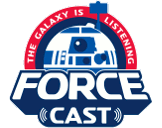This essay is from Ohad Lutzky
Published on October 5, 2001
What Does Vader's Chestplate Say
Part 2

The last word of the phrase, "ShezaCha", can also be read as "Shezooka". I will first explain why this happens:
First off - Hebrew is read from right to left. Get used to it, we did. :)
The word is composed by four letters: Sheen, Za'yin, Chaf (As in L'cha'yim, with the Chet sound that only Hebrew, Arabic and Klingonese seem to have), and Hay.
"She", at the beginning of a word, often means "that". The word "that" is simply glued to the word, and is not seperate like in English. Therefore, "Zacha" means won or "has won", and "Shezacha" means "that has won".
Sheen makes the Sh sound and Za'yin makes a Z sound. However, Hebrew has system of dots and lines around letters that works like vowels. It tells us if a Sheen should be She, Sha, Shee, Shoo, Sho, etc. It also tells us the difference between the actual sound the letter makes. Sheen, for example, has a variation called Seen. If the dot is on the top right, it will be a Sheen. However, the same letter with a dot on the top left instead, would be a Seen. The word SaMe'ach, for example, means Happy, and begins with a Seen. Similarily, Chaf (which looks like a square trimmed on the left, like a reverse, non-round C) with a dot in the middle will be Kaf.
In biblical Hebrew, the vowelization is very important. There is also additional vowelization in most of the religious texts that tells us how to sing the text during prayer. Very helpful for young musicians going through Bar-Mitzvah, as they are used to reading notes, so they don't have to remember how to sing it - they just read.
Modern Hebrew - especially on computers - is without vowelization. We use vowel letters, instead. The letter Hay, at the beginning of a syllable, will make an H sound. At the end of one, though, it will just tell us the sound is either Eh or Ah. This lets us tell the difference between words that would otherwise be different only in vowelizing punctuation.
Back to vader. The words on the chest plate are clearly written in a biblican air. However, no punctuation is there at all. The word Zooka is passive, and means "has been proved innocent" (The similarity to "Zacha", which means Won, is evident). Normally, Zooka would be written Za'yin Vav Kaf Hay, with Vav being a vowel letter. This would tell us that the word is not "Zacha", which is written Za'yin, Chaf, Hay. However, it often occurs that quoted biblical text is stripped of punctuation but not added vowel letters, therefore often becoming unintelligible. The word "Zooka" can be written without a Vav with the proper punctuation.
Now I'll explain why it makes sense that the word is actually ShezooKa.
The sentence with ShezaCha means: His actions/deeds will not be forgiven until he merits.
The sentence with ShezooKa means: His actions/deeds will not be forgiven until he is proven innocent.
The second is a reversal of one of the Mitzvot (commandments) which says: "One shall be regarded innocent until he is proven guilty", also adding to the biblical air of the phrase.
I'm not saying that the first option is illogical, nor that the second is any bit more logical. It is just another possibility to be considered.
P.S. To anyone with a Hebrew bible and a really good memory: Open Samuel A, and go to the part before Hanna's prayer. Read the part about the triple cow, and try remembering if in school you were taught that the letters got jumbled through the ages and the original phrase was "a cow as good as three", not "three cows".
Feedback welcome

